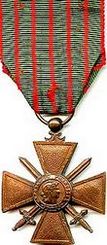Robert Foster
| Date and Place of Birth: | 1887 Pensacola Navy Yard, FL |
| Date and Place of Death: | July 28, 1918 Tardenois, France |
| Baseball Experience: | Professional |
| Position: | Unknown |
| Rank: | Corporal |
| Military Unit: | Company B, 165th Infantry Regiment, 42nd Division US Army |
| Area Served: | France |
Robert A. Foster, the son of Lieutenant Commander Charles Foster, was
born at Pensacola Navy Yard in Florida in 1887. His father, an Annapolis
graduate, had at one time commanded the cruiser USS Baltimore.
His family moved to Brooklyn when he was young and Foster graduated with
honors from De La Salle Institute in Manhattan. Standing 6-foot-2, an
expert horseman and all-around athlete, Foster played baseball with the
all-professional Old New York team. At one time he rode a horse at
Ausable Chasm, a sandstone gorge near Keeseville, New York, and narrowly
escaped death when the horse went over the cliff and was killed.
An extensive traveller, Foster also appeared in some silent movies and
was said to have posed with Mary Pickford in “The Eagle’s Mate,” in
1914. In 1916, he enlisted with New York’s 69th “Fighting Irish”
Infantry Regiment and was stationed at McAllen, Texas, along the Mexican
border during the Punitive expedition against Pancho Villa. He received
an honourable discharge as a corporal when the regiment returned to New
York, and worked for the government at Sandy Hook.
Foster re-enlisted when war was declared on Germany in April 1917.
Serving with Company B of the 69th - which was now designated the 165th
Infantry Regiment of the 42nd “Rainbow” Division - his photograph
appeared on postcards that had a large circulation at the time as a
“typical American soldier.” He sailed for France with the American
Expeditionary Force in October 1917.
In June 1918, the 42nd Division moved to the Champagne sector of France,
where it stopped the German advance in the Second Battle of the Marne.
Foster carried the Irish flag when the regiment went “over the top.”
"I held on to that old green flag," he wrote to his cousin, Emma
McGeehan, on June 14, 1918, "and went right over the top with my
comrades. I feel mighty proud of the feat, too."
The flag which Foster carried was brought back to the United States and
sent to President Wilson
in Washington.
For his “remarkable courage and bravery” he was awarded the French Croix
de Guerre (an award created to recognize French and allied soldiers who
were cited for their service during the war), and was later awarded a
star to be attached to the cross.
In July, the Division moved to Chateau Thierry to relieve the embattled
26th Division. On July 28, Foster’s regiment led the crossing of the
Ourcq River. In four days of fighting, the 3000-man regiment suffered
264 killed in action, 150 missing, and 1,200 wounded. Corporal Foster,
aged 31, was killed on the first day. He is buried at the Oise-Aisne
American Cemetery at Fere-en-Tardenois, France.
Sources:
Brooklyn Daily Eagle - September 17, 1918
Chicago Tribune - September 18, 1918
New York Sun – September 18, 1918
Date Added April 27, 2013
Can you add more information to this biography and help make it the best online resourse for this player? Contact us by email
Read Baseball's Greatest Sacrifice Through The Years - an online year-by-year account of military related deaths of ballplayers
Baseball's Greatest Sacrifice is associated with Baseball Almanac
Baseball's Greatest Sacrifice is proud to be sponsored by



